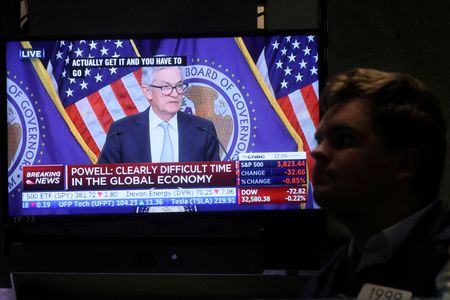By Ann Saphir
(Reuters) – Federal Reserve policymakers have all but promised to dial down the pace of their interest rate hikes next week, and over coming months feel their way to a policy rate high enough to push down on inflation, but not so high as to crash the economy.
Once they get rates to that point, in an approach one U.S. central banker has dubbed “raise and hold,” they intend to stand pat as the higher borrowing costs work their way through the economy to cool the labor market and ease price pressures.
Traders are not buying it.
After a report on Friday showing job growth did not slow as much as expected last month, futures contracts tied to U.S. short-term rates reflected bets the Fed would continue to raise rates next year, ultimately topping out just under or just over 5% by May.
But just a few months later, based on those same futures contracts, the central bank is seen turning around and cutting rates, bringing them back down by the end of 2023 to where they are expected to end this year, in the 4.25%-4.50% range.
The view that rates will follow a hump-shaped path over the coming year is one that traders have stuck to, more or less, since the Fed put its policy tightening into high gear over the summer to fight price pressures at levels not seen in 40 years.
It syncs with financial market measures like the inverted Treasury yield curve flashing warning lights about a coming recession. Many economists, too, have forecast a rise in the unemployment rate of a percentage point or more over the coming year from the current 3.7%, consistent with a recession, including some at the Fed itself.
The Fed’s typical response to a weakening economy is to cut rates. But with inflation by the Fed’s preferred measure running at three times its 2% target, economists say all bets are off – including those made by futures traders.
“I think those expectations are premature,” said Jefferies economist Aneta Markowska. “I don’t think the Fed will be comfortable cutting rates until unemployment gets close to 5%, or inflation declines south of 3%. Those conditions are unlikely to be met until 2024.”
Fed policymakers will update their forecasts for unemployment and inflation at the end of their Dec. 13-14 meeting, with some already previewing snippets of their updated outlooks.
New York Fed President John Williams last week said he does not expect inflation to fall below 3% before the end of 2023, even as unemployment, now at 3.7%, rises to between 4.5% and 5%. And rate cuts? Probably not until 2024, he said.
Other policymakers have tried to deliver a similar message, with Fed Chair Jerome Powell saying it will require “some time” and Fed Vice Chair of Supervision Michael Barr calling for a “long period” to squeeze too-high inflation from the economy.
“My colleagues and I do not want overtighten because … cutting rates is not something we want to do soon,” Powell said at a Brookings Institution event on Wednesday.
Avoiding an overshoot that could crash the economy was part of the rationale he gave for delivering a half-point rate hike next week, instead of the 75-basis-point rate increase the Fed has delivered at every meeting since June.
Powell said he believes rates will ultimately need to go “somewhat higher” than the 4.6% policymakers projected in September. But, he said, “we wouldn’t just raise rates and try to crash the economy and then clean up afterwards.”
(Writing by Ann Saphir in Berkeley, Calif.; Editing by Dan Burns and Matthew Lewis)

